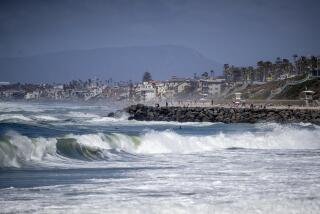Septic tanks on their way out in Malibu
- Share via
The great sewer wars of Malibu have finally drawn to a close. Sewers won.
The Los Angeles Regional Water Quality Control Board agreed late Thursday to ban septic systems in central and eastern Malibu, a move that would end years of fierce debate over the wastewater devices still commonly used in one of Southern California’s most picturesque and exclusive coastal communities.
New septic systems will not be permitted in Malibu and owners of existing systems will have to halt wastewater discharges within a decade.
While many had come to view the septic systems as a strange but effective check against rapid growth in a community beloved for its thinly populated canyons and wide-open ocean vistas, others saw the devices as Third World contrivances that have fouled the community’s watershed and popular beaches.
Hundreds attended the nearly 10-hour meeting -- from surfers to Chamber of Commerce leaders -- and the emotion all but spilled over.
Surfer Ken Seino, a member of the Malibu Surfing Assn., pulled open his shirt to show a scar on his upper-left chest, where he had a pacemaker implanted. That was necessary, he said, because of the viral myocarditis he contracted after paddling through raw sewage at Surfrider Beach in the summer of 1997.
“I smelled it, I tasted it, and it was ugly,” Seino, 53, said. “I regurgitated before I could paddle to the sand.” He said he eventually needed a pacemaker.
“I will die before my time because of this infection,” he said.
Marilyn Dove challenged the water board’s technical memos as being flawed by faulty data and incorrect assumptions about the amounts and causes of Malibu’s water pollution. “If we don’t know where we’re going, all directions are wrong,” Dove said.
The plan adopted Thursday was hammered out on the fly -- a blend of the water board’s own proposal, an alternative pushed by the city and suggestions from the boisterous gathering at the Los Angeles headquarters of the Metropolitan Water District of Southern California.
The shift to a sewer system comes at considerable expense. Residents in affected areas would be required to pay about $500 a month to cover the cost of hooking into a central sewage system, according to the city’s projections. And businesses would face payments of up to $20,000 a month.
The compromise, however, shrinks the affected area and gives business owners and residents alike more time to hook into a central wastewater treatment system. Property owners in commercial areas will have to comply by 2015, and residents in Malibu Knolls, Serra Retreat and other residential areas will have until 2019.
In many ways, the septic tanks played a large role in Malibu becoming a city. It incorporated and formed its own government in 1991 to stave off Los Angeles County’s efforts to install a sewer system in the area. Residents at the time feared sewers would unleash a wave of development that would turn Malibu into Miami Beach West.
In Malibu, septic tanks, leach pits and the ubiquitous stench known as the “Malibu smell” are familiar topics. After rainstorms, officials often post signs on Surfrider Beach urging swimmers and surfers to steer clear because of health dangers. Surfrider often gets failing grades on Heal the Bay’s annual water-quality report cards.
For years, the community has come under increasing pressure from regional, state and federal officials to clean up Malibu Creek, Malibu Lagoon and Santa Monica Bay.
City leaders contend they committed themselves long ago to cleaning up their waters by conducting studies and paying $25 million for a civic center property that will serve as a park and storm-water treatment plant. Construction on that project, called Legacy Park, recently got underway and is expected to cost at least $10 million.
Finding a way to deal with wastewater has proved more difficult. The City Council last year approved the La Paz shopping complex after the developer agreed to donate two acres for a wastewater treatment plant. But Santa Monica Baykeeper, an environmental group, sued the city, saying La Paz would pollute the creek, lagoon and ocean. Separately, Baykeeper sued the city over Legacy Park because it did not have a wastewater treatment component.
“It’s pretty tough to get things done when we’re getting sued for doing it and not doing it,” Mayor Pro Tem Sharon Barovsky said earlier this week.
Mark Gold, president of Heal the Bay, an environmental group that pushed for a septic tank prohibition, said after all these years, he was finally pleased with the resolution.
--
More to Read
Sign up for Essential California
The most important California stories and recommendations in your inbox every morning.
You may occasionally receive promotional content from the Los Angeles Times.














